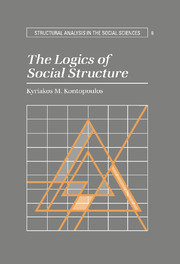Book contents
- Frontmatter
- Contents
- Preface
- Introduction
- Part I Metatheoretical considerations
- Part II Compositionist logics
- Part III Logics of hierarchy
- 8 Hierarchy theory and postfunctional analysis
- 9 The hierarchical theory of social structure
- Part IV Heteracrchical logics
- Part V The phenomenology of social structures
- Appendix: The logics of structuration
- Glossary
- Bibliography
- Index
9 - The hierarchical theory of social structure
Published online by Cambridge University Press: 24 October 2009
- Frontmatter
- Contents
- Preface
- Introduction
- Part I Metatheoretical considerations
- Part II Compositionist logics
- Part III Logics of hierarchy
- 8 Hierarchy theory and postfunctional analysis
- 9 The hierarchical theory of social structure
- Part IV Heteracrchical logics
- Part V The phenomenology of social structures
- Appendix: The logics of structuration
- Glossary
- Bibliography
- Index
Summary
The utility of a commonsensically conceived hierarchical theory in macrosociology is taken for granted by a large number of social theorists. The Marxian and Durkheimian legacies have given the social sciences foundational grounds and descriptive vocabularies that seem to breed hierarchical or straightforward collectivist modes of theorizing: It is intuitively grasped that any emphasis on the autonomy and explanatory primacy of societal phenomena necessarily rests on “group-theoretical” assumptions, namely, that macrophenomena have superseded their microconstitution and govern the microdimensions of social life in their own dynamic way.
We have already seen that any macrotheory may be defended from the usual reductionist attacks both as regards its diachronic constitution and its synchronic operations. In synchronic terms, proponents of a macrotheory are bound to argue defensively the nonreducibility of macrophenomena to microphenomena or microprocesses (the “holist”thesis) and, possibly, take the stronger position that macrophenomena “reach down” causally and determine, constrain, parameterize, or condition the preferences, motivations, rationality, values, and so on, implicated in the actions and interactions of microagents (the thesis of “downward causation”). On the diachronic front, macrotheory advocates may also follow two distinct strategies to support their arguments on the autonomous status of macrostructures: they may either (a) refer to ecological-evolutionary and group-selectionist macroprocesses (Al-drich et al. 1986; Stanley 1979; Vrba 1984; Wynne Edwards 1986) that explain the autonomous development of macrophenomena; or (b) they may accept the notion of the diachronic emergence of macrophenomena out of microprocesses, adding to it the qualifying proposition that, once diachronic emergence takes place, the macrophenomena “supersede” the prior and lower-order microphenomena or, at least, in a weaker sense, prevail and establish a “governance” over these microphenomena (Pattee 1973; Salthe 1985; Webster 1979).
- Type
- Chapter
- Information
- The Logics of Social Structure , pp. 180 - 208Publisher: Cambridge University PressPrint publication year: 1993



